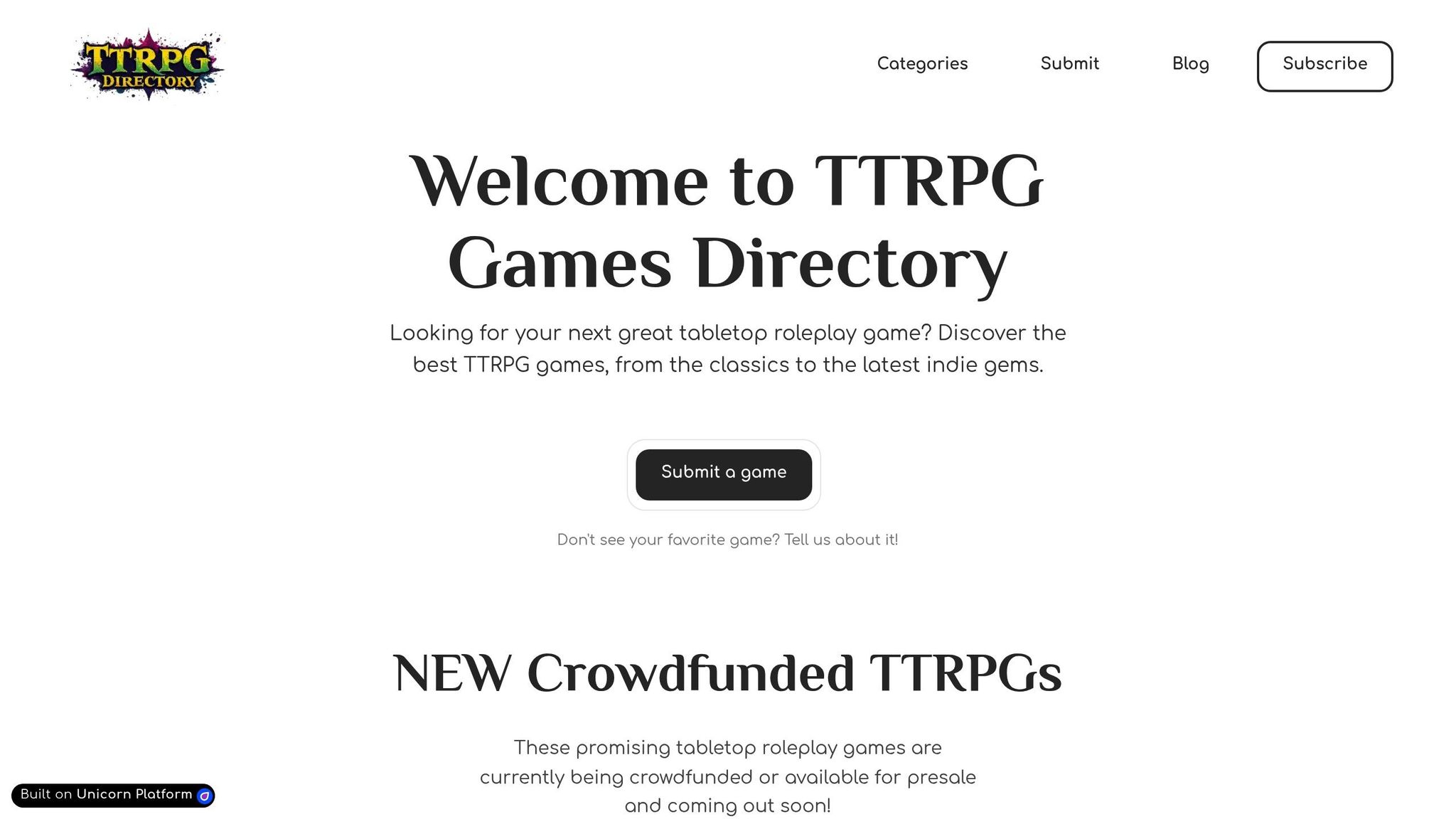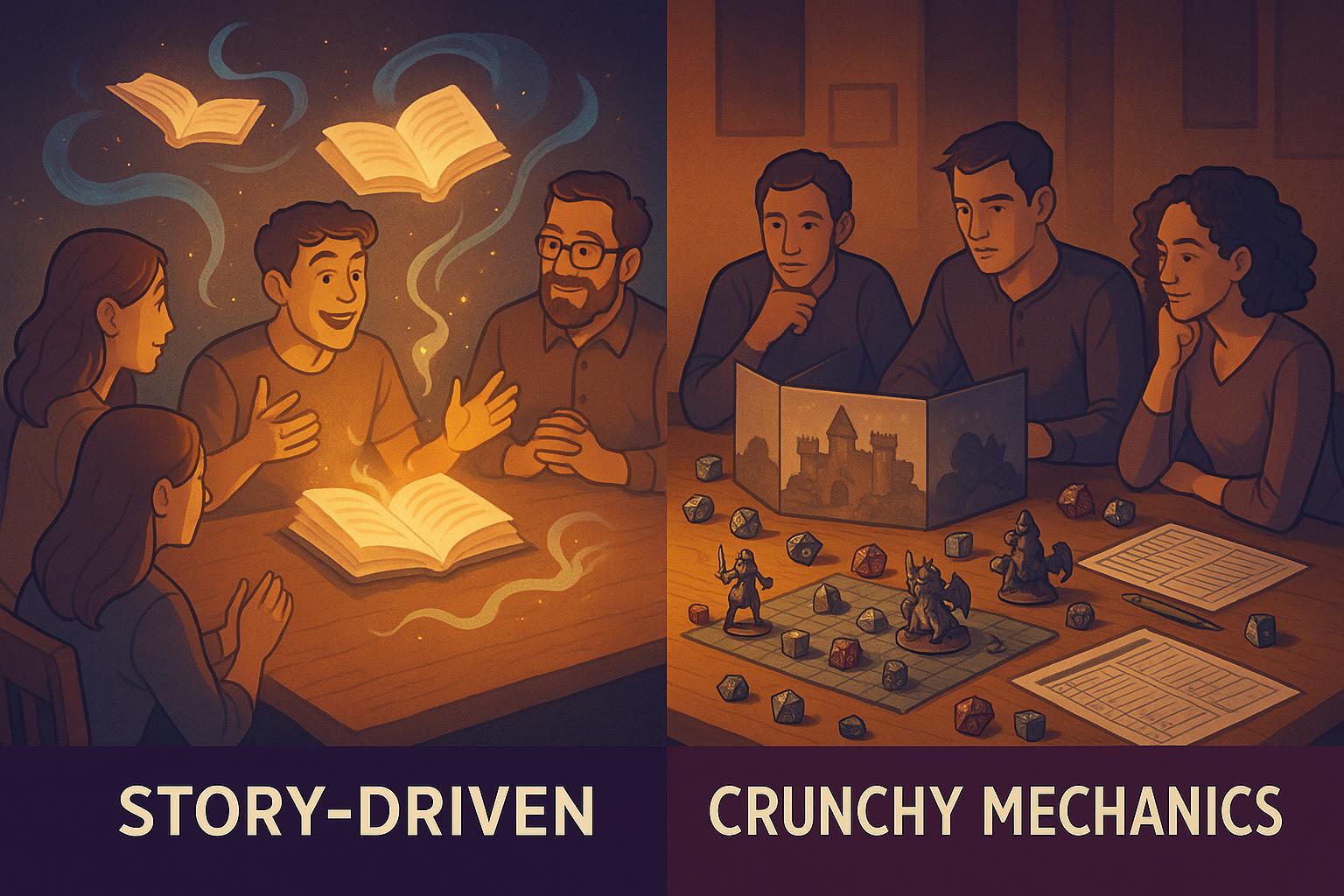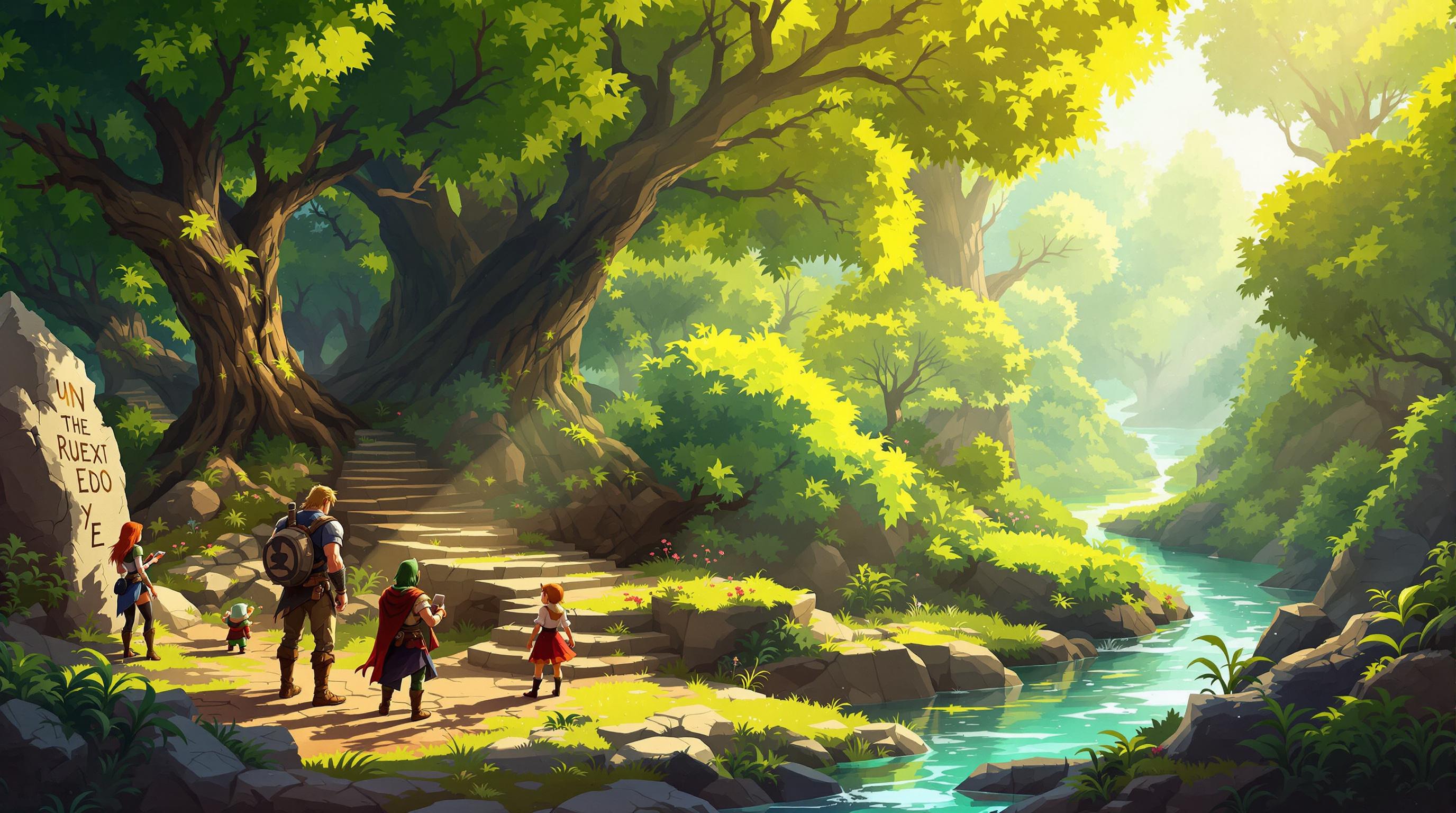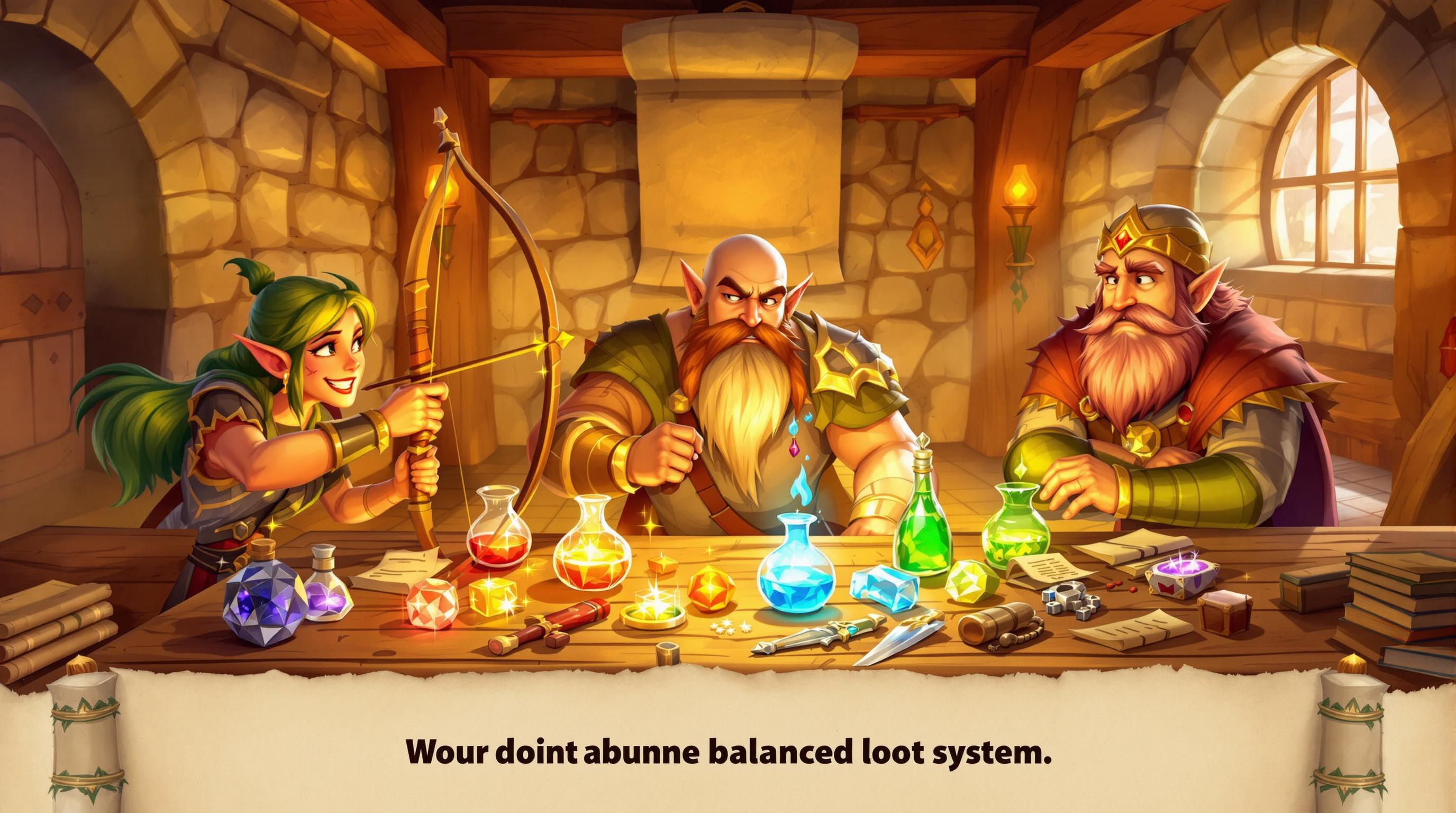Class balancing in RPGs ensures every player feels impactful and engaged. A well-designed system gives each class a clear purpose, avoids overpowered abilities, and prevents redundancy. Here's a quick breakdown of what matters:
- Core Roles: Tanks absorb damage, Strikers deal high damage, Leaders heal and buff, and Controllers manage the battlefield.
- Common Problems: Overpowered abilities, unused skills, role overlap, and resource imbalances can ruin gameplay.
- Balance Strategies:
- Set performance benchmarks (damage, survivability, utility).
- Introduce trade-offs (e.g., resource limits or situational abilities).
- Manage the action economy to avoid any class dominating turns.
- Testing: Playtesting and feedback are critical for refining balance.
- Tools: Use systems like point-buy for fairness and role matrices to ensure every class stands out.
Balanced classes create synergy, making gameplay engaging without overshadowing others. This guide dives into proven methods to achieve that balance while keeping the experience fun and rewarding.
Problematic Character Classes: Should You Ban or Balance? - GM Tips | Art of the Game
RPG Class Roles and Party Structure
A well-defined class role system is the backbone of a cohesive RPG party. When every class has a clear function and contributes meaningfully, players feel valued and integral to their group's success. The trick is to design roles that complement each other rather than compete for the spotlight.
Main Class Roles: Tank, Damage Dealer, Support, Utility
Most RPG systems revolve around four primary roles, each addressing a specific need within the party. These roles - Defenders, Strikers, Leaders, and Controllers - form the foundation of effective team dynamics.
- Defenders (commonly referred to as tanks) focus on shielding the party by drawing enemy attention and absorbing damage. They excel at managing the battlefield through smart positioning and controlling threats, as seen with classes like Fighters.
- Strikers specialize in dealing concentrated damage to single targets. Rogues, for instance, shine in this role, using their agility and precision to eliminate high-priority threats quickly.
- Leaders are the party's backbone, offering healing, buffs, and tactical support. Clerics are a classic example, ensuring their teammates stay in fighting shape and perform at their peak.
- Controllers manipulate the battlefield, handling groups of enemies through crowd control, hazardous terrain, or status effects. Wizards are a prime example, using their spells to neutralize threats that single-target damage can't handle.
This framework was notably formalized in Dungeons & Dragons 4th Edition, which categorized classes into these four archetypes: Defender, Striker, Leader, and Controller. This clear structure made party composition intuitive and helped players quickly grasp their responsibilities.
Why Each Class Needs a Clear Purpose
Distinct roles are essential for balanced gameplay. When classes overlap too much, some can feel redundant, especially if one outshines the others in performing a shared function. For instance, if two classes are designed to heal but one is significantly better, the weaker option might be sidelined. By giving each class a unique purpose, every character can make meaningful contributions to the group.
This clarity also aids developers in crafting mechanics and abilities. Instead of trying to make every class capable of doing everything, they can focus on refining each class's strengths to fulfill its intended role. This approach ensures a more engaging experience for players, as they can specialize and feel indispensable to their team's success.
How Different Roles Work Together
When roles are well-defined, they naturally create synergy within a party. Each role supports the others, enhancing overall performance and ensuring no one feels left out. For example:
- Defenders protect Strikers, allowing them to focus on dealing damage without constantly dodging attacks.
- Controllers set up tactical opportunities, like crowd-controlling enemies, which Strikers can exploit to maximize damage.
- Leaders keep everyone in fighting form, boosting the group's effectiveness during tough encounters.
The classic adventuring party of a Cleric, Fighter, Rogue, and Wizard exemplifies this synergy perfectly. The Fighter defends, the Rogue eliminates threats, the Cleric heals and buffs, and the Wizard controls the battlefield. Together, they cover all critical needs without stepping on each other's toes.
Modern RPGs often allow classes to fill multiple roles, adding flexibility to party composition. For instance, a Paladin might act as both a Defender and a Leader, while a Ranger could blend Striker and Controller abilities. This versatility enables creative team setups while maintaining the importance of clear role distinctions.
To encourage teamwork, many games include abilities that work better in combination. A Controller might cast a spell that makes enemies more vulnerable to a Striker's attacks, or a Leader's buff could amplify a Defender's protective skills. These interactions reward coordination and make the gameplay experience more dynamic and engaging.
Core Mechanics for Class Balance
When it comes to balancing RPG classes, understanding the core mechanics is just as important as analyzing their roles. A well-balanced system ensures that every class holds its ground without overshadowing others. This is achieved by setting clear performance benchmarks, crafting meaningful trade-offs, and maintaining controlled gameplay dynamics.
Setting Performance Standards for Classes
Every balanced RPG system establishes performance benchmarks for each class. These benchmarks act as a yardstick to measure whether a class is underpowered or dominating the game.
Take damage output, for instance. It’s more than just raw numbers. A fighter might deliver steady, consistent damage, while a rogue could excel in burst damage under specific conditions. Meanwhile, a wizard might shine when targeting groups but struggle against single, tougher foes.
Survivability metrics go beyond just hit points. They account for defensive abilities, mobility, and recovery options. For example, a defender might have high armor and health, along with abilities to draw enemy attention. On the other hand, a damage-dealing class might rely on mobility or stealth to make up for weaker defenses.
Utility contributions are harder to quantify but equally crucial. Every class should bring something unique to the table outside of combat. A cleric’s healing or a rogue’s specialized skills can be game-changers in specific situations. These contributions ensure that each class feels indispensable in its own way.
Using tools like spreadsheets to track metrics - such as damage per round, defensive ratings, and utility effectiveness - can help identify imbalances before they disrupt gameplay. Once these benchmarks are clear, the next step is to balance power with meaningful limitations.
Trading Power for Limitations
To keep things fair, powerful abilities need to come with meaningful trade-offs. The best class designs force players to make tough choices, balancing impressive capabilities with significant constraints.
Resource limits are a classic way to balance power. For example, a wizard’s devastating spells might be limited to a few uses per day. Similarly, some abilities might offer huge bonuses but require players to manage resources carefully.
Situational restrictions also play a key role. A rogue’s sneak attack, for instance, might deal massive damage but only under specific conditions, like when an ally is nearby or the rogue has the advantage. Similarly, a paladin’s abilities might only activate against certain foes or under strict moral guidelines.
Opportunity costs add another layer of depth. If a cleric has to choose between healing an ally on the brink of death or casting an offensive spell, that decision creates tension and keeps gameplay engaging.
"Players will often say they've had the most fun not in situations where the battle was perfectly balanced, but instead in games where they had a very slight advantage the entire time. That way, they were always winning, but the enemy put up enough of a fight that they felt scared"
- Rob Pardo, VP of Game Design, Blizzard Entertainment
Rob Pardo’s insight underscores the importance of limitations that create tension without crippling a class. These trade-offs enhance the experience by encouraging strategic decision-making.
Managing Actions and Resources
The action economy - how much a class can accomplish in a turn - is one of the most critical aspects of balance. If one class consistently does more in a turn than others, the system quickly becomes unbalanced.
Most systems limit characters to one major action per turn, but classes can differentiate themselves through bonus actions, reactions, and passive abilities. For instance, a fighter might deliver multiple attacks in one turn, while a cleric could cast a spell as their main action and heal as a bonus action.
Stamina and cooldown mechanics offer another way to balance abilities. Instead of traditional spell slots or daily-use powers, some classes might spend stamina points for powerful moves. This approach works well for martial classes, giving them a dynamic edge similar to spellcasters.
It’s also essential to ensure no class consistently outshines others. For instance, if one class can deal damage, move, and hide all in a single turn, others should have compensatory strengths - like higher damage potential, stronger defenses, or abilities that affect multiple enemies.
Balancing resources like hit points and healing options is just as important. Encounters should feel strategic and engaging rather than repetitive or overly punishing. Monitoring how each class performs across different encounter types and over longer adventuring days can help ensure that every class has its moment to shine, whether in short skirmishes or extended battles.
sbb-itb-b8b00a5
Methods for Designing Balanced Classes
Designing balanced RPG classes is all about creating fairness while letting each class shine in its own way. The goal is to make sure classes complement each other, rather than stepping on each other's toes. Here are some practical methods to turn theoretical balance into well-rounded class designs.
Point-Buy Systems for Class Creation
Point-buy systems are a structured way to ensure balance by forcing trade-offs during class creation. The idea is simple: assign a fixed number of points that must be distributed across a class’s abilities. For instance, if a class is built to deal massive damage, it might need to give up defensive strength or utility. On the flip side, a tanky class with high survivability might sacrifice raw damage output.
Take GURPS (Generic Universal RolePlaying System) as an example. In GURPS, players spend points on attributes, skills, and advantages, while balancing them with disadvantages to stay within a set total. This system ensures fairness while allowing players to build highly customized characters.
To make a point-buy system work well, you need clear performance benchmarks - like average damage per round or standard healing output. It’s also important to cap how many points can be spent in any one area to avoid overpowered builds. Regular playtesting and tweaking based on feedback are key to keeping the system balanced as the game evolves.
Preventing Class Role Overlap
Every class should feel distinct, even if multiple classes share similar roles. A good way to achieve this is by defining each class’s primary and secondary roles early on. Tools like a role matrix can help map out responsibilities and highlight any potential overlaps.
For example, imagine two spellcasters who both specialize in area damage. One could focus purely on raw destruction with minimal defenses, while the other might balance moderate damage with battlefield control or healing. Even though they share a role, their playstyles would feel entirely different. Another way to create distinction is by varying resource systems - one class might rely on daily spell slots, while another uses a regenerating stamina pool. These differences push players to approach challenges in unique ways.
If overlaps do happen, you can tweak class features by adding situational mechanics or unique abilities. This preserves each class’s flavor without stripping away their core strengths.
Testing and Refining Through Play
No matter how well-designed a class looks on paper, it’s the actual gameplay that reveals whether it works. Playtesting is essential to see how classes perform in different scenarios. A class that dominates short skirmishes might struggle in long campaigns, while another might thrive in social settings but falter in combat.
During testing, track key metrics like damage output, healing, and skill success rates. Just as important is gathering player feedback - how a class feels to play can be just as telling as raw numbers.
Balance isn’t a one-and-done process. Issues can surface over time, so it’s important to keep refining based on community feedback. Iterative updates help ensure that the game remains engaging and balanced as players explore its full potential.
Using Resources for Class Design Ideas
Building on the methods we’ve already discussed, tapping into external resources can help you fine-tune your approach to class balancing. By studying successful RPG systems, you can sidestep common design pitfalls and discover fresh ways to enhance your classes. This kind of research pairs perfectly with the strategies we’ve covered so far.
Drawing Inspiration from the TTRPG Games Directory

The TTRPG Games Directory is a treasure trove for anyone crafting RPG classes. It catalogs a wide range of tabletop RPGs, from time-tested classics to inventive indie titles, offering insights into game mechanics, themes, and unique features. It’s an excellent starting point for brainstorming and refining your class designs.
Use the directory to find games with themes or mechanics similar to your own. Pay close attention to how these games handle traditional class archetypes or push boundaries by blending roles. For example, you might stumble upon a system where classes are designed to adapt based on party needs or where roles evolve depending on the phase of gameplay.
The directory simplifies the research process by pointing you toward systems that align with your design goals. As you explore, take note of what makes each game’s class mechanics stand out. You might discover innovative ideas, like dynamic abilities that shift based on party composition or unique ways to integrate narrative elements into class roles.
Learning from Well-Designed RPG Systems
Beyond online resources, diving into established RPG systems can give you a deeper understanding of effective class design. Take Dungeons & Dragons 5th Edition, for example. Its balanced approach to class progression, meaningful choices at various levels, and clever resource management (like the interplay between short and long rests) demonstrates how pacing and balance can work hand in hand.
Another standout is Pathfinder 2nd Edition, which uses a three-action economy to ensure every class feels impactful during gameplay. This system prevents any one character from dominating a turn while giving players plenty of opportunities to customize their class through feats, all while maintaining each class’s core identity.
For something more unconventional, look at Blades in the Dark. Its playbooks, which act as character archetypes, combine narrative hooks with mechanical depth, ensuring every character has a role in both storytelling and combat. Similarly, 13th Age excels at defining class identities by giving each class signature abilities that are exclusive and irreplaceable, making every party member’s role vital.
As you study these systems, keeping a mechanics notebook can be a game-changer. Jot down interesting design choices - how games handle resource management, define roles, or prevent overlap between classes. Look for patterns in how successful systems achieve synergy within a party while maintaining distinctiveness for each class.
The goal isn’t to copy mechanics outright but to understand the principles behind them. For instance, a resource system that balances short-term power with long-term planning in one game might inspire a similar, tailored approach in your own design. By focusing on the "why" behind these mechanics, you can adapt ideas to fit your unique vision.
Conclusion: Creating Balanced RPG Classes
Designing balanced RPG classes is an ongoing journey, not a one-time task. In this guide, we’ve broken down the key elements of class design - defining unique roles, establishing clear mechanics, and using smart design strategies. The goal isn’t to achieve perfect mathematical balance but to create classes that feel distinct, enjoyable, and meaningful to play.
One effective strategy is leaning into asymmetrical balance. This means classes excel in different areas rather than being equally strong across the board. Take Dungeons & Dragons 5th Edition as an example: the Fighter shines in sustained combat, the Wizard offers versatility and area control, and the Cleric provides healing and support. Every class has its moment to stand out, ensuring no single character dominates the party. This approach keeps gameplay dynamic and encourages continuous refinement through updates and player feedback.
Speaking of feedback, community involvement and playtesting are vital. These processes help uncover issues that might otherwise go unnoticed, making iterative design a necessity. Balance isn’t a fixed state - it evolves as new content and expansions are introduced. Revisiting and adjusting classes regularly ensures they stay relevant and engaging.
The concept of "perfect imbalance" also plays an important role. By allowing different classes to take the spotlight with new content, you can keep the gameplay fresh and exciting, even if temporary imbalances arise.
To refine your designs further, explore external resources for inspiration. Platforms like TTRPG Games Directory showcase how various systems tackle class balance, offering valuable examples from both classic and modern approaches. Adopting a flexible design philosophy ensures each class has a clear purpose and contributes meaningfully to the party dynamic.
Ultimately, great class balance stems from creating clear distinctions between roles, empowering players to make informed choices, and delivering an engaging experience. Tap into your community’s insights, analyze gameplay data, and let those experiences guide your designs. Balanced classes aren’t just about fairness - they’re about crafting memorable and rewarding adventures.
FAQs
What’s the best way to test and gather feedback to balance RPG character classes?
To fine-tune the balance of RPG character classes, start by setting up playtest sessions with groups of 5–10 players. Make sure to include a mix of playstyles and experience levels - this variety will help you spot a broader range of balance issues. During these sessions, closely watch how players interact and how each class performs across different scenarios. Take detailed notes on what works and what doesn’t.
Once the playtests are over, collect feedback from participants. You can use surveys, host group discussions, or even have one-on-one chats to dive deeper into their experiences. Focus on key areas like how the mechanics feel, whether the classes seem fair, and how much fun players had overall. Balancing is an ongoing process, so be ready to tweak things after each round of testing. Also, pay attention to non-verbal cues, like how engaged players seem during the game - these can often reveal just as much as their words about what needs improvement.
What are some effective trade-offs to ensure balanced character classes in an RPG?
Balancing character classes in an RPG often comes down to introducing meaningful trade-offs that keep gameplay engaging. For instance, you could balance power against resource management, forcing players to weigh the benefits of immediate strength against conserving resources for future challenges. Similarly, offering a choice between versatility and specialization allows players to decide whether they want a character that's highly skilled in one area or decent across multiple roles.
Another intriguing approach is incorporating moral or ethical dilemmas. Imagine granting powerful abilities that come with story-altering consequences - perhaps impacting relationships with other characters or shifting the narrative itself. Multi-classing is another way to spice things up, offering players flexibility at the expense of losing mastery in a single role. These kinds of decisions ensure no class feels too dominant or too weak, keeping the experience balanced and exciting.
How do point-buy systems help balance RPG classes, and what are the best ways to use them effectively?
Point-buy systems are a popular way to keep RPG classes balanced. They give players a set number of points to spread across their character’s attributes, ensuring no one ends up with an overly powerful character. This approach not only levels the playing field but also encourages players to think carefully about their choices.
To make the most of a point-buy system, consider adding diminishing returns for higher attribute investments. This discourages players from overloading points into a single stat and encourages more balanced builds. Setting clear caps on how many points can go into each attribute is another way to maintain fairness. By rewarding well-rounded characters instead of extreme min-maxing, the system helps ensure that everyone at the table has a fun and fair experience.


